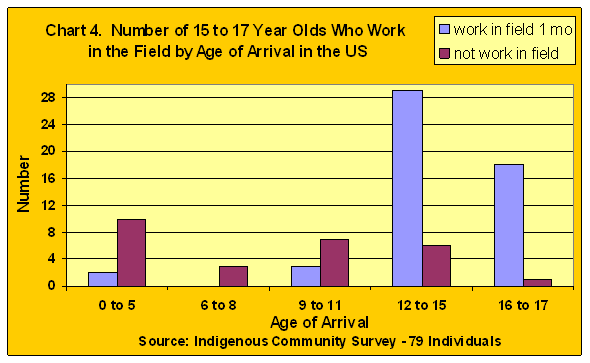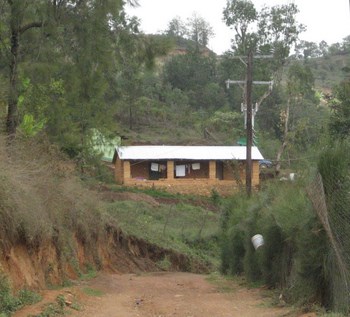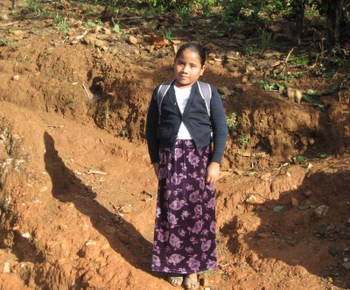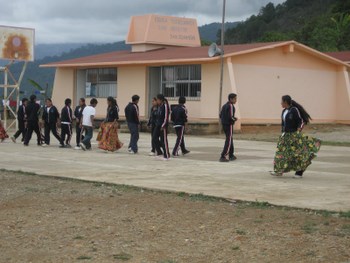Education
The indigenous have less schooling than mestizos
Low levels of schooling among indigenous accounts for stagnation in education for farmworkers
Children immigrating after age 11 go to work, not to school
The indigenous have less schooling than mestizos
 Indigenous farmworkers have fewer years of school than their Mestizo counterparts. This group of young Mixtecs spend spring and summer picking strawberries near Santa Maria. Photo copyright David Bacon
Indigenous farmworkers have fewer years of school than their Mestizo counterparts. This group of young Mixtecs spend spring and summer picking strawberries near Santa Maria. Photo copyright David BaconDespite the reputation of comparatively poor schooling in the indigenous areas, it is difficult to demonstrate in official data that the indigenous have lower educational levels. Nevertheless, there are two indicators worth highlighting. First, the National Agricultural Workers Survey for California shows fewer years of school completed in Mexico for young indigenous immigrants than for young mestizos. For people 18 to 25 years old at the time of the survey, the indigenous averaged 6.5 years of school compared to 7.3 for the mestizos. This disadvantage for the indigenous is particularly noticeable for the female population. Second, there is evidence that in addition to a disadvantage in number of years of school, the indigenous areas also offer a lower quality of education due to lower levels of available resources allocated to these areas and to language barriers.
Low levels of schooling among indigenous accounts for stagnation in education for farmworkers
The observation that the indigenous have lower educational levels is not surprising since the indigenous often come from remote towns without educational services. California’s farm labor force is continuously being replenished with young workers from Mexico as older veteran workers leave the fields. Now, given that the educational level in Mexico has been steadily rising in recent decades, one would expect that the overall educational level of Mexican farmworkers in California to be increasing as well. However, this is not the case. This surprising contradiction is in part due to the influx of newcomers from remote indigenous areas.
Consider the following facts. First, the educational level in Mexico has gone up over time. Namely, younger Mexicans in general (and younger Mexicans working in California agriculture) have significantly more education than older ones on average (see Chart 1). The ones who are now over 60 had very little opportunity to go to school at all. Also, be aware that over time the average age of Mexican workers in California agriculture has not changed very much. The average age does not change since the labor market is continuously being replenished with new and young workers as older veteran workers leave the fields. According to the best information, the average age of farmworkers has fluctuated around 30 years old since data collection began by the Department of Labor’s National Agricultural Workers Survey (NAWS) in 1989. As a result, one would expect the average educational level to go up over the decades as the more educated Mexican immigrants enter California agriculture. But, this has not happened. From 1989 to 2008, the NAWS shows that for every year without exception the typical Mexican farmworker in California had only six years of school.
How can this be? How do we explain this apparent contradiction? We think it can be explained by the fact that the newer immigrants come from remote areas of Mexico (to a great extent indigenous) that have not experienced improvements in education. And, these newer arrivals (many of whom are indigenous) have less schooling and therefore hold down the average levels among all farmworkers.
Among the respondents in our Indigenous Community Survey lower levels of education are associated with difficult road access between the respondent’s home village and major urban centers. In the table below, we compare the nine case study towns which are the focus of our study. Notice that the more remote the town, the lower the educational leveled recorded by the Mexican census. We know that in the migratory source regions of Mexico, more remote areas (many of them indigenous) have fewer political assets, poorer roads and they receive fewer educational resources. Since California agriculture is being continuously replenished by new waves of immigrants, as the older cohorts move out of field work, we conclude that the average educational level of farmworkers is not improving because the source of immigrants is continuously shifting to more remote, often indigenous areas, with lower levels of education.
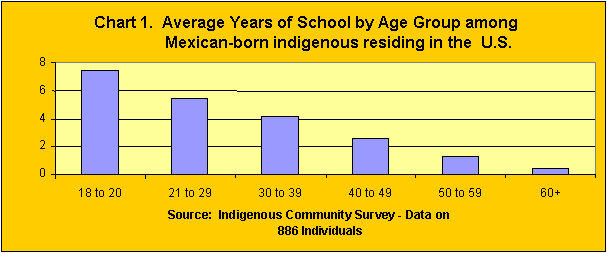
| Table: Average Years of School by Remoteness of the Town to Major Cities in Mexico (18 to 25 years old only) | ||
| Town | Mean School | State Of Road |
| tepos | 9.8 | paved road to big town (near Tlaxiaco) |
| cuevas | 7.8 | paved road to big town (near Juxtlahuaca) |
| candelaria | 7.7 | 45 minutes. from Chalcatongo by gravel road |
| cerro | 7.1 | 45 minutes from Santos Reyes Nopala by gravel road |
| venado | 6.7 | 1 hr, dirt from Putla Villa de Guerrero |
| loxicha | 6.5 | 1.5 hrs. gravel and dirt to main road to Pochutla |
| piñas | 6.2 | 1.25 hrs, dirt & gravel road to Juxtlahuaca |
| peras | 4.4 | 1.25 hrs, dirt & gravel road to Juxtlahuaca |
| jicayan | 4 | 3 hrs, gravel & dirt to Juxtlahuaca |
Children immigrating after age 11 go to work, not school
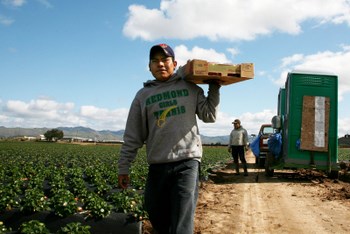 Older indigenous children who arrive after the age of 12 go to work in the fields and are unlikely to finish school. This Mixtec youth works picking strawberries near Santa Maria. Photo copyright David Bacon
Older indigenous children who arrive after the age of 12 go to work in the fields and are unlikely to finish school. This Mixtec youth works picking strawberries near Santa Maria. Photo copyright David BaconThe age of arrival has a major impact on whether an indigenous immigrant child is able to attend school consistently in the United States or whether instead he or she goes to work in California’s fields. First, notice in Chart 2 below that most indigenous children living in California are U.S.-born. Taken overall, seven out of ten of the U.S. indigenous residents less than 18 were born north of the border. Almost half of the child residents in the households in the Indigenous Community Survey are less than six. However, as is evident in Chart 2, the older the child, the greater the likelihood of being born in Mexico. For those over 11, most of the indigenous children were born in Mexico.
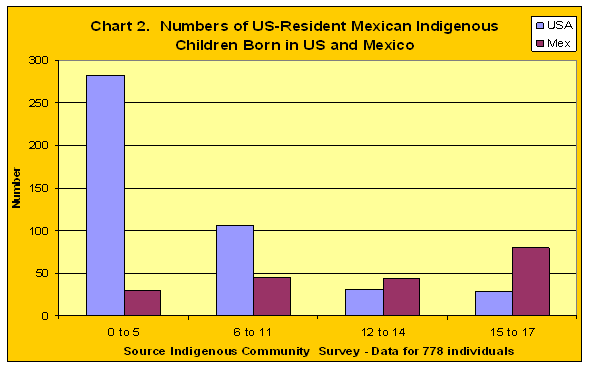
 Indigenous children who immigrate before the age of 12, or who are born in the U.S., have a greater chance of getting an education. The parents of these young Mixtecs are from San Martin Peras, Oaxaca. The family lives near Watsonville and works in the strawberry fields. Photo copyright David Bacon
Indigenous children who immigrate before the age of 12, or who are born in the U.S., have a greater chance of getting an education. The parents of these young Mixtecs are from San Martin Peras, Oaxaca. The family lives near Watsonville and works in the strawberry fields. Photo copyright David BaconFirst, let us discuss how a later age of arrival handicaps the educational achievement of the indigenous immigrant child. Looking just at young people 17 to 20 for which we have information from our survey, we find that those that came before age 12 eventually achieved a median of 10 years of school while those who came at 12 or older only achieved a median of 7 years of school. In Chart 3, one can observe a major shift when age of arrival is approximately 10 or 11 years old. After this age, educational achievement (above the eighth grade) becomes less likely. It is apparent that age of arrival becomes critical for education. Not surprisingly, among the U.S.-born in our survey, the achievement is even higher still. The typical years of school achieved for these U.S. citizens is 11.5 years.
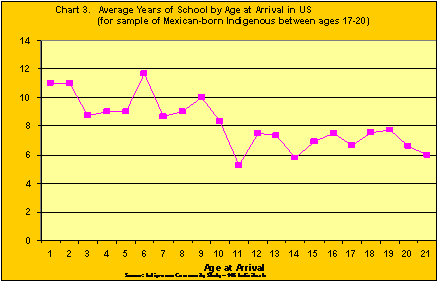
Moreover, young people who arrive after 11 years old don’t go to school, in part, because they work in the fields. Among the Mexican-born children from 15 to 17 found in our survey, over two-thirds arrived at age 12 or older. And, as shown in Chart 4, the vast majority of those who arrived at 12 years or older work a month or more per year in the fields, while the majority of those 15 to 17 year olds who came earlier in their life do not work in agriculture. It is clear that age of arrival determines to a large extent both whether one works in the fields and the eventual level of education.
